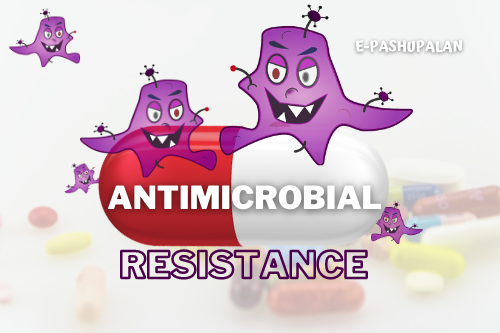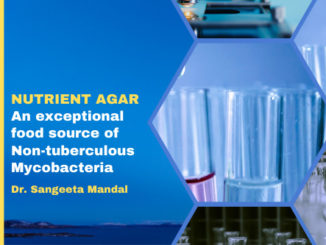Introduction
Antimicrobials is a broader term comprising of various drugs like antibiotics, antivirals, antifungals and antiparasitics which are used to prevent and treat infections in humans, animals and plants. Antimicrobial Resistance (AMR) refers to the ability of a microorganism to survive and grow in the presence of antimicrobial drugs. This occurs when bacteria, viruses, fungi and parasites change over time and they are no longer inhibited by an antimicrobial to which they were previously sensitive. As a result of this, antimicrobials become ineffective making treatment of the infections harder and the risk of disease spread, severe illness and death increases. The problem of AMR has the potential to affect people at any stage of life, and several industries like the healthcare, veterinary, and agriculture industries, making it one of the world’s most urgent public health problems.
How does AMR develop?
AMR develops naturally in microbes. Such resistance is encoded by resistance genes in the DNA of the microbe. Resistance genes can arise through spontaneous mutations in the microbial DNA or by the acquisition of genetic information through horizontal gene transfer. However, certain action of ours can increase the development and spread of AMR. The main cause of antibiotic resistance is aggressive, persistent antibiotic usage and failure to use them as directed by health care professionals. When antibiotics are used injudiciously, the selective pressure on the microbial community is increased and therefore bacteria generate more adaptive solutions to the applied stress and become resistant, faster. These resistant bacteria survive, multiply and spread more widely within a population, or to other populations or environments.

The practices like over prescription of antimicrobials, not completing prescribed courses of antimicrobial treatment and non-prescription purchase of antimicrobials have escalated the problem of AMR. The extensive use of antimicrobials in sub-therapeutic concentrations as antibiotic growth promoters and for mass prophylaxis in veterinary sector and the gross application of the antimicrobials to the crops in order to increase the yield of the high quality product also adds to the problem of AMR. The reluctance to get vaccinated makes people more susceptible to infectious diseases thus increasing reservoirs of pathogen within society which may subsequently become antimicrobial resistant.
Dissemination of resistant germs
Resistant germs are a One Health problem and they can spread between people, animals and the environment. The resistant microbes can spread:
- From person to person through poor hygiene & close proximity via coughing, sneezing or exposure with the body fluids
- Between animals and humans via direct contact with the animals or through food
- Through environment by contamination of water and soil via manure, municipal wastewater, water discharge from crop fields treated with antimicrobials
Current situation of AMR
High rates of resistance against antibiotics are frequently being observed for common bacterial infections globally, indicating that we are running out of effective antibiotics. The selection of resistant bacterial strains is driven by excess use of antimicrobials in all sectors. Antibiotic-resistant strains have emerged in various organisms like Escherichia coli, Staphylococcus aureus, Enterococcus species, Pseudomonas aeruginosa, Acinetobacter species and Klebsiella pneumonia. Resistance in E. coli to fluoroquinolone antibiotics, used for the treatment of urinary tract infections, is widely spread. Multi-drug resistant tuberculosis and extensively drug-resistant (XDR) strains causing tuberculosis (XDR-TB) have also emerged due to resistance in Mycobacterium tuberculosis which is threatening to mankind. As per WHO in 2018, there were about half a million new cases worldwide of rifampicin-resistant TB, of which the vast majority have multi-drug resistant TB (MDR-TB), a form of tuberculosis that is resistant to the two most powerful anti-TB drugs. Drug-resistance for the last resort antibiotics i.e. carbapenems and colistin has been reported in organisms. Other examples are Vancomycin-resistant Enterococci (VRE), superbugs like Enterococcus faecium, Staphylococcus aureus, Klebsiella pneumoniae, Acinetobacter baumanii, Pseudomonas aeruginosa, and Enterobacter species which are emerging globally and can be treated only with high end antibiotics. The emergence of drug-resistant parasites also poses threats to malaria control and results in morbidity and mortality. Artemisinin-based combination therapies (ACTs) are the recommended first-line treatment for uncomplicated P. falciparum malaria and are used by most malaria endemic countries. In the WHO South-East Asia Region, partial resistance to artemisinin and resistance to a number of the ACT partner drugs has been confirmed in several regions. There is a limited documentation about the exact amount of antibiotics consumed in India; hence, it is very cumbersome to elicit data on antibiotic consumption.
Impact of AMR
Due to the rising AMR cases, serious infections such as tuberculosis, malaria, pneumonia are becoming harder to treat as antibiotics become less effective. Many routine medical procedures such as organ transplantation, chemotherapy for cancer treatment, intensive care for pre-term newborns and many other activities are becoming too risky to perform because of the risk of becoming infected by a multi-drug resistant pathogen. In our country, deaths of nearly 60,000 newborns occur as a result of antibiotic-resistant neonatal infections each year. Minor infections could become life threatening as a result of AMR and global trade can also get affected as travelling will be considered too risky.
The economic impact of antibiotic resistance also needs to be taken into account. Increased resistance is causing an increase in the costs associated with more expensive second- or third-line drugs that are to be used when infections become resistant to first-line antimicrobials. AMR is resulting in the elevation of treatment cost because of use of specialised equipments, longer hospital stays and isolation procedures for the patients. Societal costs owing to the deaths and loss of productivity adds up to the economic losses.
In the US alone, as per the estimates of CDC annually more than two million infections are caused by bacteria that are resistant to at least first-line antibiotic treatments, costing the US health system $55 billion per year overall. Of this two million people, at least 23,000 die as a result of the antibiotic-resistant infections and this death toll is expected to reach an estimate of 10 million annual deaths by 2050, costing global economic output of 100 trillion USD. The World Bank has predicted that by 2050, the annual global GDP could fall by 3.8% and an additional 28.3 million people could fall into extreme poverty due to AMR.
Measures to combat AMR
- The incidence of infection should be reduced by keeping up to date with vaccinations
- Improve in basic hygiene needs to be practiced to prevent infections by regularly washing of hands
- Antibiotics should only be taken when they are prescribed for you and leftover antibiotics shouldn’t be shared
- Health professionals should only prescribe antibiotics when they are needed based on the symptoms
- Instructions given by the health professional’s should be followed when you or your pet are prescribed antibiotics
- It is to be understand that antibiotics don’t work for colds and flus which are caused by viruses and only work against bacteria
- Awareness and understanding of AMR can be improved through effective communication, education and training
- The use of antimicrobial agents in health, animals and food should be optimized
- Surveillance programmes should be strengthened to improve knowledge and evidence regarding AMR
- International, national and state level collaborations need to be setup to ensure action against AMR
Conclusion
AMR is particularly problematic because the antibiotic usage to treat bacterial infections has increased whereas the discovery and development of novel antibiotics has slowed. In addition to this, the routine use of antibiotics to enhance food animal and crop production also significantly increases the probability of developing resistance. One Health approach is mandatory to deal with this problem globally, by reducing demand for new antibiotics through public awareness, infection prevention and control, prudent and rational use of antibiotics as well as effective diagnosis and surveillance of antibiotic-resistant infections and antibiotic use.
References
- Review on Antimicrobial Resistance. Tackling drug-resistant infections globally: final report and recommendations. May 2016. Available at: https://amr-review.org/sites/default/files/160525_Final%20paper_with%20cover.pdfLast accessed March 2020.
- Review on Antimicrobial Resistance. Tackling a crisis for the health and wealth of nations. December 2014. Available at: https://amr-review.org/sites/default/files/AMR%20Review%20Paper%20%20Tackling%20a%20crisis%20for%20the%20health%20and%20wealth%20of%20nations_1.pdfLast accessed March 2020.
- The World Bank. By 2050, drug-resistant infections could cause global economic damage on par with 2008 financial crisis. September 20 2016. Available at: http://www.worldbank.org/en/news/press-release/2016/09/18/by-2050-drug-resistant-infections-could-cause-global-economic-damage-on-par-with-2008-financial-crisis Last accessed March 2020.
- Prestinaci, F., Pezzotti, P., & Pantosti, A. (2015). Antimicrobial resistance: a global multifaceted phenomenon. Pathogens and global health, 109(7), 309-318.
- Michael, C. A., Dominey-Howes, D., & Labbate, M. (2014). The antimicrobial resistance crisis: causes, consequences, and management. Frontiers in public health, 2, 145.
- National Action Plan on Antimicrobial Resistance. 2017. Ministry of Health & Family Welfare, GoI. Available at: https://www.ncdc.gov.in/WriteReadData/linkimages/AMR/File645.pdf







Be the first to comment